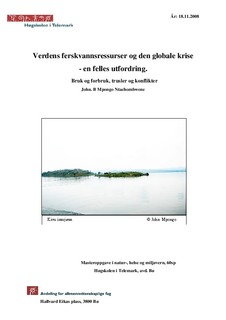| dc.description.abstract | The objective of this thesis is to provide an overview of the world's freshwater situation with focus on drinking water. The assessment is mainly based on literary sources, including current knowledge of the water resources and water management. The global freshwater crisis leaves large parts of humanity to a life in poverty and living conditions characterised by vulnerability and insecurity. The water crisis does not attract the same weight of attention in the media as wars and natural disasters do. Yet, this crisis claim more human lives as a result of disease than any war does. The bulk of the water on earth is found in the large ocean areas (97.5%). Lakes, rivers and streams account for only a small fraction of the water on the earth (about 0.3%). Most of the fresh water is found in the form of icebergs and snow (68.9%) and ground water (29.9%). Water is used for many purposes, such as drinking water, in hygiene, agriculture, industry and recreation. Global freshwater withdrawals are almost doubled since 1960. The use of fresh water increases 2.5 times faster than the population growth. While the Earth's population was tripled in the last century, water consumption raised six folds. Globally, about 277 million hectars of land is under irrigation. Agriculture is the largest consumer of freshwater, with 70 % of the freshwater consumption. Artificial irrigation in agriculture has tripled since 1950 and 40 % of food production in the world today comes from irrigated agricultural areas. The industry accounts for 23% and households for 7 % of the water consumption. Over-consumption of ground water resources is one of the most serious problems in the water sector today. Ground water level declines because of this. It is expected that consumption will continue to increase in the future as a result of population growth. There is a battle for water in many regions of the world. Approximately 40 % of the world's population depends on fresh water which originates from neighbouring countries. More than 200 major rivers in the world are divided between two or more countries. Disagreement over the use of this water has turned into a political issue and a source of conflicts in several places on earth. This is the case within the Nile, Jordan, Euphrates, Tigris and the Ganges. Of the world's population of about 6.6 billion, at least 1.1 billion people do not have access to clean drinking water. Almost half of the world's population is in a situation where they cannot satisfy their basic hygienic requirements. In other words, 1.1 billion people live under extreme poverty world-wide. For this reason, we can talk about a global water crisis. The global water crisis is a set of local water crises that gradually broadens and increase in scope. Pollution, overuse, uneven distribution and poor water management of freshwater are the most important reasons for water scarcity on earth. Many of the environmental problems know no boundaries. The water cycle is a fragile system that is constantly threatened by environmental pollution. Sewage can seep into groundwater, or run out into rivers or lakes, thus, contaminating the only water resources in the area. Elsewhere, however, emissions from industrial and agricultural establishments play a central role in environmental pollution. Pollution resulting from heavy metals and other chemical substances create a serious problem to drinking water. Arsenic contaminated groundwater is a constant problem in Bangladesh, where more than 35 million of the people drink contaminated groundwater every day. This has caused major health problems in Bangladesh, including cancer, food poisoning and skin disorders. The incidences and outbreaks of water-related diseases is one of the greatest threats to human health on earth. Of all the world's disease cases, 80 % are water related and more than three million die each year because of water problems. Most patients with water related diseases live in the poorest areas of developing countries. Poverty reduction is one of the United Nations??main priorities, and permanent access to clean water is essential to combat poverty. According to the European Union?? Water Directive, water supply shall be safe, monitored and protected so that drinking water does not pose a potential threat and source for spread of infectious substances. Everyone is entitled to sufficient drinking water of good quality. At least 20-50 liters of clean water are needed per person per day, according to the World Health Organizations (WHO). A minimum of two hygienic barriers in our water supply system is acceptable, according to paragraph 14 of the Norwegian Drinking Water Act. Many of the water-based ecosystems are destroyed as a result of dam construction, drainage of wetland areas, and drawing of water for industry, agriculture and households, or pollution from these activities. This results in the extermination of many species; others are threatened or sharply reduced. In comparison to the period 1980-1999, UN?? climate panels expect a rise in mean global temperature of 1.1 to 6.4 º C from 2090 to 2099. Sea levels are expected to rise with 19 to 58 cm in the same period. Most likely, climate change will lead to more floods, drought periods, heat waves and diseases in many places on earth. Insecurities due to flooding and drought can be reinforced by climate change. The poorest people in the driest areas are likely to be hit the hardest. There is enough freshwater on earth today. The problem is rather that many do not have access to it. This is due to uneven distribution of water resources and power. The world's population increases by 74 million people each year. Areas with water scarcity are expected to increase from the current 31 to 48 countries in 2025. If this trend continues in the same rate 2/3 of the world's population will live in areas with fresh water shortage by 2025. | |
